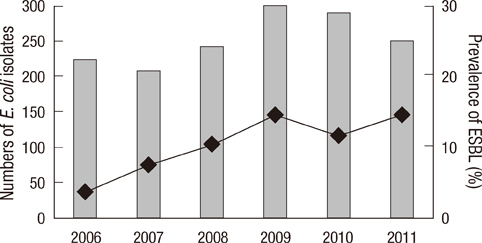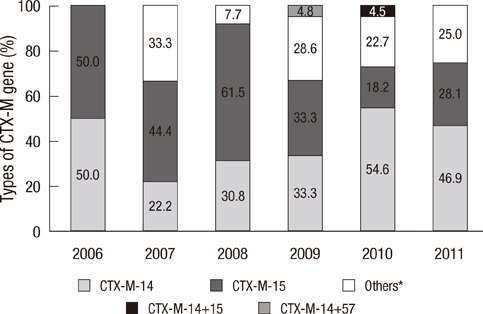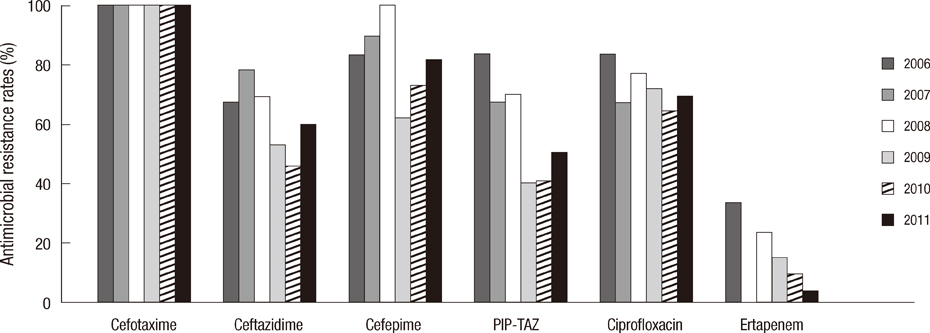J Korean Med Sci.
2013 Jul;28(7):998-1004. 10.3346/jkms.2013.28.7.998.
Clinical and Molecular Epidemiology of Community-Onset Bacteremia Caused by Extended-Spectrum beta-Lactamase-Producing Escherichia coli over a 6-Year Period
- Affiliations
-
- 1Division of Infectious Diseases, Samsung Medical Center, Sungkyunkwan University School of Medicine, Seoul, Korea. collacin@hotmail.com
- 2Asia Pacific Foundation for Infectious Diseases (APFID), Seoul, Korea.
- 3Department of Molecular Cell Biology, Sungkyunkwan University School of Medicine, Suwon, Korea.
- 4Division of Infectious Diseases, Samsung Changwon Hospital, Sungkyunkwan University School of Medicine, Changwon, Korea.
- 5Department of Laboratory Medicine, Samsung Medical Center, Sungkyunkwan University School of Medicine, Seoul, Korea.
- KMID: 1777494
- DOI: http://doi.org/10.3346/jkms.2013.28.7.998
Abstract
- Although extended-spectrum beta-lactamase-producing Escherichia coli (ESBL-EC) has emerged as a significant community-acquired pathogen, there is little epidemiological information regarding community-onset bacteremia due to ESBL-EC. A retrospective observational study from 2006 through 2011 was performed to evaluate the epidemiology of community-onset bacteremia caused by ESBL-EC. In a six-year period, the proportion of ESBL-EC responsible for causing community-onset bacteremia had increased significantly, from 3.6% in 2006 to 14.3%, in 2011. Of the 97 clinically evaluable cases with ESBL-EC bacteremia, 32 (33.0%) were further classified as healthcare-associated infections. The most common site of infection was urinary tract infection (n=35, 36.1%), followed by biliary tract infections (n=29, 29.9%). Of the 103 ESBL-EC isolates, 43 (41.7%) produced CTX-M-14 and 36 (35.0%) produced CTX-M-15. In the multilocus sequence typing (MLST) analysis of 76 isolates with CTX-M-14 or -15 type ESBLs, the most prevalent sequence type (ST) was ST131 (n=15, 19.7%), followed by ST405 (n=12, 15.8%) and ST648 (n=8, 10.5%). No significant differences in clinical features were found in the ST131 group versus the other group. These findings suggest that epidemic ESBL-EC clones such as CTX-M-14 or -15 type ESBLs and ST131 have disseminated in community-onset infections, even in bloodstream infections, which are the most serious type of infection.
Keyword
MeSH Terms
-
Aging
Bacteremia/drug therapy/*epidemiology
Biliary Tract Diseases/epidemiology/microbiology
Cephalosporin Resistance/genetics
Cephalosporins/therapeutic use
Community-Acquired Infections/*epidemiology/microbiology
Escherichia coli/isolation & purification/metabolism
Escherichia coli Infections/drug therapy/*epidemiology
Female
Humans
Male
Microbial Sensitivity Tests
Molecular Epidemiology
Multilocus Sequence Typing
Prevalence
Retrospective Studies
Urinary Tract Infections/epidemiology/microbiology
beta-Lactamases/*metabolism
Cephalosporins
beta-Lactamases
Figure
Cited by 2 articles
-
Change in the Annual Antibiotic Susceptibility of Escherichia coli in Community-Onset Urinary Tract Infection between 2008 and 2017 in a Tertiary Care Hospital in Korea
Young Jun Kim, Jeong-Mi Lee, Jihyun Cho, JaeHoon Lee
J Korean Med Sci. 2019;34(34):. doi: 10.3346/jkms.2019.34.e228.What’s New in the Management of Bacterial Infections in the Era of Multidrug-Resistant Bacteria?
Cheol-In Kang
J Korean Soc Transplant. 2013;27(3):81-86. doi: 10.4285/jkstn.2013.27.3.81.
Reference
-
1. Rogers BA, Sidjabat HE, Paterson DL. Escherichia coli O25b-ST131: a pandemic, multiresistant, community-associated strain. J Antimicrob Chemother. 2011; 66:1–14.2. Johnson JR, Nicolas-Chanoine MH, DebRoy C, Castanheira M, Robicsek A, Hansen G, Weissman S, Urban C, Platell J, Trott D, et al. Comparison of Escherichia coli ST131 pulsotypes, by epidemiologic traits, 1967-2009. Emerg Infect Dis. 2012; 18:598–607.3. Croxall G, Hale J, Weston V, Manning G, Cheetham P, Achtman M, McNally A. Molecular epidemiology of extraintestinal pathogenic Escherichia coli isolates from a regional cohort of elderly patients highlights the prevalence of ST131 strains with increased antimicrobial resistance in both community and hospital care settings. J Antimicrob Chemother. 2011; 66:2501–2508.4. Chung HC, Lai CH, Lin JN, Huang CK, Liang SH, Chen WF, Shih YC, Lin HH, Wang JL. Bacteremia caused by extended-spectrum-β-lactamase-producing Escherichia coli sequence type ST131 and non-ST131 clones: comparison of demographic data, clinical features, and mortality. Antimicrob Agents Chemother. 2012; 56:618–622.5. Johnson JR, Urban C, Weissman SJ, Jorgensen JH, Lewis JS 2nd, Hansen G, Edelstein PH, Robicsek A, Cleary T, Adachi J, et al. Molecular epidemiological analysis of Escherichia coli sequence type ST131 (O25:H4) and blaCTX-M-15 among extended-spectrum-β-lactamase-producing E. coli from the United States, 2000 to 2009. Antimicrob Agents Chemother. 2012; 56:2364–2370.6. Khanna N, Boyes J, Lansdell PM, Hamouda A, Amyes SG. Molecular epidemiology and antimicrobial resistance pattern of extended-spectrum-β-lactamase-producing Enterobacteriaceae in Glasgow, Scotland. J Antimicrob Chemother. 2012; 67:573–577.7. Peirano G, Sang JH, Pitondo-Silva A, Laupland KB, Pitout JD. Molecular epidemiology of extended-spectrum-β-lactamase-producing Klebsiella pneumoniae over a 10 year period in Calgary, Canada. J Antimicrob Chemother. 2012; 67:1114–1120.8. Rodríguez-Baño J, Alcalá JC, Cisneros JM, Grill F, Oliver A, Horcajada JP, Tórtola T, Mirelis B, Navarro G, Cuenca M, et al. Community infections caused by extended-spectrum beta-lactamase-producing Escherichia coli. Arch Intern Med. 2008; 168:1897–1902.9. Rodríguez-Baño J, Picón E, Gijón P, Hernández JR, Ruíz M, Peña C, Almela M, Almirante B, Grill F, Colomina J, et al. Community-onset bacteremia due to extended-spectrum beta-lactamase-producing Escherichia coli: risk factors and prognosis. Clin Infect Dis. 2010; 50:40–48.10. Van der Bij AK, Peirano G, Goessens WH, van der Vorm ER, van Westreenen M, Pitout JD. Clinical and molecular characteristics of extended-spectrum-beta-lactamase-producing Escherichia coli causing bacteremia in the Rotterdam Area, Netherlands. Antimicrob Agents Chemother. 2011; 55:3576–3578.11. Peirano G, Costello M, Pitout JD. Molecular characteristics of extended-spectrum beta-lactamase-producing Escherichia coli from the Chicago area: high prevalence of ST131 producing CTX-M-15 in community hospitals. Int J Antimicrob Agents. 2010; 36:19–23.12. Park SH, Choi SM, Lee DG, Kim J, Choi JH, Kim SH, Kwon JC, Yoo JH. Emergence of extended-spectrum β-lactamase-producing escherichia coli as a cause of community-onset bacteremia in South Korea: risk factors and clinical outcomes. Microb Drug Resist. 2011; 17:537–544.13. Friedman ND, Kaye KS, Stout JE, McGarry SA, Trivette SL, Briggs JP, Lamm W, Clark C, MacFarquhar J, Walton AL, et al. Health care: associated bloodstream infections in adults: a reason to change the accepted definition of community-acquired infections. Ann Intern Med. 2002; 137:791–797.14. Kim J, Lim YM, Jeong YS, Seol SY. Occurrence of CTX-M-3, CTX-M-15, CTX-M-14, and CTX-M-9 extended-spectrum beta-lactamases in Enterobacteriaceae clinical isolates in Korea. Antimicrob Agents Chemother. 2005; 49:1572–1575.15. Kim J, Lim YM, Rheem I, Lee Y, Lee JC, Seol SY, Lee YC, Cho DT. CTX-M and SHV-12 beta-lactamases are the most common extended-spectrum enzymes in clinical isolates of Escherichia coli and Klebsiella pneumoniae collected from 3 university hospitals within Korea. FEMS Microbiol Lett. 2005; 245:93–98.16. Lau SH, Reddy S, Cheesbrough J, Bolton FJ, Willshaw G, Cheasty T, Fox AJ, Upton M. Major uropathogenic Escherichia coli strain isolated in the northwest of England identified by multilocus sequence typing. J Clin Microbiol. 2008; 46:1076–1080.17. Lee MY, Choi HJ, Choi JY, Song M, Song Y, Kim SW, Chang HH, Jung SI, Kim YS, Ki HK, et al. Dissemination of ST131 and ST393 community-onset, ciprofloxacin-resistant Escherichia coli clones causing urinary tract infections in Korea. J Infect. 2010; 60:146–153.18. Peirano G, van der Bij AK, Gregson DB, Pitout JD. Molecular epidemiology over an 11-year period (2000 to 2010) of extended-spectrum β-lactamase-producing Escherichia coli causing bacteremia in a centralized Canadian region. J Clin Microbiol. 2012; 50:294–299.19. Peirano G, Pitout JD. Molecular epidemiology of Escherichia coli producing CTX-M beta-lactamases: the worldwide emergence of clone ST131 O25:H4. Int J Antimicrob Agents. 2010; 35:316–321.20. Sullivan CB, Diggle MA, Clarke SC. Multilocus sequence typing: data analysis in clinical microbiology and public health. Mol Biotechnol. 2005; 29:245–254.21. Kang CI, Wi YM, Lee MY, Ko KS, Chung DR, Peck KR, Lee NY, Song JH. Epidemiology and risk factors of community onset infections caused by extended-spectrum β-lactamase-producing Escherichia coli strains. J Clin Microbiol. 2012; 50:312–317.22. Kang CI, Cheong HS, Chung DR, Peck KR, Song JH, Oh MD, Choe KW. Clinical features and outcome of community-onset bloodstream infections caused by extended-spectrum beta-lactamase-producing Escherichia coli. Eur J Clin Microbiol Infect Dis. 2008; 27:85–88.23. Kang CI, Song JH, Chung DR, Peck KR, Ko KS, Yeom JS, Ki HK, Son JS, Lee SS, Kim YS, et al. Risk factors and treatment outcomes of community-onset bacteraemia caused by extended-spectrum beta-lactamase-producing Escherichia coli. Int J Antimicrob Agents. 2010; 36:284–287.
- Full Text Links
- Actions
-
Cited
- CITED
-
- Close
- Share
- Similar articles
-
- Community-onset Necrotizing Fasciitis Caused by Extended-spectrum Beta-lactamase-producing Eshcerichia coli
- A Case Report of Sepsis by Extended-Spectrum beta-Lactamase Producing Escherichia Coli
- Risk Factors of Nosocomial Bacteremia of Extended-spectrum beta-Lactamase Producing Escherichia coli
- In Vitro Susceptibility of piperacillin/tazobactam Against extended-spectrum beta-lactamase-producing Escherichia coli and Klebsiella pneumoniae
- Risk Factors and Molecular Epidemiology of Community-Onset Extended-Spectrum beta-Lactamase-Producing Escherichia coli Bacteremia




